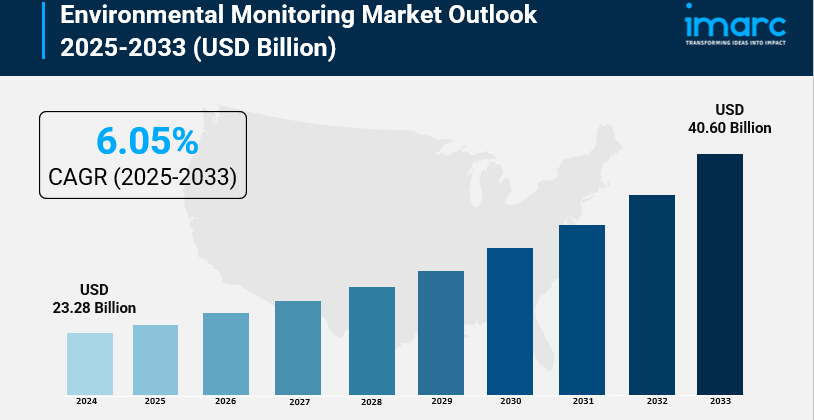IMARC Group, a leading market research company, has recently releases a report titled “Environmental Monitoring Market Size, Share, Trends and Forecast by Component, Product Type, Sampling Method, Application, and Region, 2025-2033.” The study provides a detailed analysis of the industry, including the global environmental monitoring market size, share, trends, and growth forecast. The report also includes competitor and regional analysis and highlights the latest advancements in the market.
Environmental Monitoring Market Highlights:
- Environmental Monitoring Market Size (2024): Valued at USD 23.28 Billion.
- Environmental Monitoring Market Forecast (2025–2033): The environmental monitoring market size is expected to reach USD 40.60 billion by 2033, growing at a CAGR of 6.05%.
- Market Growth: The environmental monitoring market is experiencing significant growth due to increasing environmental concerns and regulatory requirements.
- Key Drivers: Major factors driving the market include climate change, pollution control, and the need for sustainable practices.
- Technology Advancements: Innovations in sensor technology and data analytics are enhancing monitoring capabilities and accuracy.
- Application Areas: Key applications include air quality monitoring, water quality analysis, soil monitoring, and noise monitoring.
- Geographical Insights: North America are leading region, driven by stringent environmental regulations and advanced technology adoption.
- Market Challenges: Challenges include high costs of monitoring equipment and the need for skilled personnel to interpret data effectively.
- Future Trends: The market is expected to witness increased integration of IoT and AI technologies for real-time monitoring and data management.
Request for a sample copy of the report: https://www.imarcgroup.com/environmental-monitoring-market/requestsample
Our report includes:
Market Dynamics
Market Trends and Market Outlook
Competitive Analysis
Industry Segmentation
Strategic Recommendations
Industry Trends and Drivers:
Stringent Government Regulations and Policies:
A primary driver for the environmental monitoring market is the increasing stringency of government regulations and environmental policies worldwide. As governments become more aware of the severe impacts of pollution and climate change, they are implementing and enforcing stricter rules on industries to ensure compliance. For example, laws related to air quality, water discharge, and waste management mandate that businesses and municipalities install monitoring systems to track their emissions and effluents in real time. Failure to comply often results in heavy fines, legal penalties, or even operational shutdowns, which provides a strong financial incentive for companies to invest in robust monitoring solutions. These regulations create a consistent, non-negotiable demand for monitoring equipment, from sensors that detect particulate matter to systems that analyze water and soil contamination. This trend is particularly evident in developing economies that are experiencing rapid industrialization and are now prioritizing sustainable development to mitigate environmental degradation.
Advancements in Technology and Innovation:
Technological advancements serve as a significant catalyst for the growth of the environmental monitoring market. The integration of cutting-edge technologies like the Internet of Things (IoT), artificial intelligence (AI), and remote sensing has transformed monitoring from a manual, intermittent process into a continuous, data-driven one. IoT-enabled sensors can collect and transmit real-time data on air and water quality from remote locations, allowing for immediate response to potential hazards. AI and machine learning algorithms are used to analyze vast datasets, identify pollution sources, and predict future environmental trends with greater accuracy than ever before. Furthermore, remote sensing technologies, such as satellite imagery and drones equipped with specialized sensors, enable large-scale environmental surveillance, monitoring everything from deforestation to changes in sea level. These innovations not only improve the accuracy and efficiency of monitoring but also make the technology more accessible and cost-effective, thus expanding its adoption across various sectors.
Growing Public and Corporate Environmental Consciousness:
The rise in public and corporate environmental consciousness is a powerful, organic force propelling the environmental monitoring market. Modern consumers are increasingly concerned about the health risks associated with pollution and climate change, leading to greater demand for transparency from both governments and corporations. This public pressure motivates companies to adopt more sustainable practices and openly report their environmental impact, which, in turn, requires sophisticated monitoring tools. Simultaneously, many corporations are now embracing environmental, social, and governance (ESG) goals as a core part of their business strategy, viewing sustainability not just as a regulatory burden but as a competitive advantage. Companies are investing in monitoring solutions to reduce their carbon footprint, manage resources more efficiently, and demonstrate their commitment to environmental stewardship to investors and customers. This shift from simple compliance to a proactive, value-based approach is creating a new wave of demand for advanced monitoring and data analytics systems.
Environmental Monitoring Market Report Segmentation:
Breakup By Component:
- Particulate Detection
- Chemical Detection
- Biological Detection
- Temperature Sensing
- Moisture Detection
- Noise Measurement
Breakup by Product Type:
- Environmental Monitoring Sensors
- Environmental Monitors
- Environmental Monitoring Software
- Wearable Environmental Monitors
Breakup by Sampling Method:
- Continuous Monitoring
- Active Monitoring
- Passive Monitoring
- Intermittent Monitoring
Breakup by Application:
- Air Pollution Monitoring
- Water Pollution Monitoring
- Soil Pollution Monitoring
- Noise Pollution Monitoring
Breakup By Region:
- North America (United States, Canada)
- Asia Pacific (China, Japan, India, South Korea, Australia, Indonesia, Others)
- Europe (Germany, France, United Kingdom, Italy, Spain, Russia, Others)
- Latin America (Brazil, Mexico, Others)
- Middle East and Africa
Who are the key players operating in the industry?
The report covers the major market players including:
- 3M Company
- Agilent Technologies Inc.
- Danaher Corporation
- Emerson Electric Co.
- General Electric
- Honeywell International Inc.
- Horiba Ltd.
- Merck KGaA
- Siemens AG
- TE Connectivity
- Teledyne Technologies Incorporated
- Thermo Fisher Scientific Inc.
Ask Analyst & Browse full report with TOC List of Figures: https://www.imarcgroup.com/request?type=report&id=4296&flag=C
If you require any specific information that is not covered currently within the scope of the report, we will provide the same as a part of the customization.
Contact US:
IMARC Group
134 N 4th St. Brooklyn, NY 11249, USA
Email: [email protected]
Tel No:(D) +91 120 433 0800
United States: +1-201971-6302




Top comments (0)